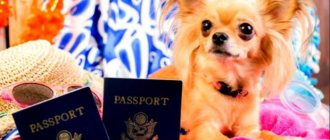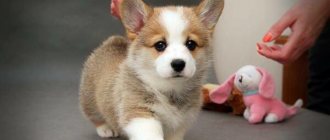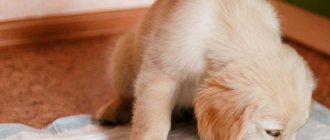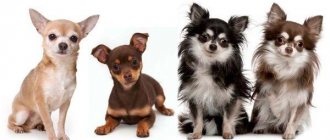Puppy branding is a procedure carried out by a club or kennel. Dogs of all breeds registered in the Russian Canine Federation (RKF) must have a brand. Therefore, to the question of whether a puppy must be branded, the answer is simple: yes, if the pet is purebred. Moreover, the breeder is responsible for this procedure, since branding, according to the Regulations of the RKF, is carried out by the responsible territorial canine organizations or the owner of the kennel.
What is puppy metric?
A puppy card is a document consisting of two parts: an upper and a lower part (tear-off coupon). The information in them is the same, that is, duplicated. This is due to the fact that in the future the upper part of the metric can be exchanged for an extract from the RKF Verkhovna Rada ( full pedigree of the RKF ), and the tear-off coupon remains with the owner. It is important not to lose the tear-off coupon, because if the pedigree is lost, it will help in restoring the document. You will also need it when registering for exhibitions (in accordance with the regulations on certificated exhibitions of the RKF, you can register for an exhibition based on puppy metrics in the baby, puppy, and junior classes).
The metric is given by the breeder along with the puppy. The owner purchases a puppy with a ready-made metric.
Please note that all puppies purchased from cynological organizations included in the RKF system have this document.
The metric indicates all the features of a particular dog, the brand number, and information about the parents. If fundamental deficiencies are identified or if revision is necessary, a note to this effect must be made in the document. For example, if a puppy was rejected, then the reason must be indicated. Or, perhaps, the issuance of the puppy’s certificate was delayed due to temporary developmental defects, which can be corrected over time, then the card indicates the date of revision, on the basis of which the document can be issued in the future.
When the metric is not issued
We figured out what a puppy's metric is. This is a document certifying his breed. But not every dog has one. If a puppy is purchased simply from hand, and not from a professional nursery, it will not have a metric.
Such a baby, even if he is a puppy from champions three times, is simply a phenotype of the breed. In other words, it has external signs of a representative of one or another breed, but this is not documented. Phenotypes are not allowed for exhibitions, they cannot take part in breeding, because such dogs do not carry any breeding value.
If the puppy was rejected for some reason, then he will not see the metrics and pedigree in the future.
What information should it contain?
The card contains the following basic information about the puppy:
- breed;
- nickname;
- date of birth;
- floor;
- color;
- stamp number;
- information about father and mother;
- information about the breeder;
- Full name and address of the puppy's owner.
When receiving your puppy's metric, make sure that:
- the stamp on the card contains a letter code in Latin, and there are no dashes in the columns of the card;
- All items that must be filled out are typed and not filled out by hand. Only the columns “Owner” and his “Address” are filled in by hand.
All metrics issued by clubs and nurseries that are part of the RKF system are printed on the official RKF letterhead and must be certified by the seal of the organization (club or nursery), which is indicated in the header of the document.
The metric must be certified by the signature of the responsible person and the seal of the organization (club or nursery), which is indicated in the header of the document.
What information is included in the certificate?
The puppy card must contain the following information:
- Nickname.
- Breed.
- Date of Birth.
- Color.
- Details of the baby's parents.
- Brand number.
- Special marks - a column in which data on breeding marriage is entered.
- Breeder and owner details.
- Signature of the responsible person.
- Seal of the kennel club.
Read How to take a dog abroad: 3 basic documents for hassle-free travel
How to check if a metric is real?
To avoid becoming a victim of scammers, you need to check the authenticity of the card before purchasing a puppy. This can be done by contacting the nursery/club indicated in the metric and finding out whether they have registered a puppy with the brand indicated in the metric.
You can check the data on the RKF.Online website in the “Dog registration data” section . To do this, in the information field you must enter the code and number of the brand indicated by the breeder in the metric.
Please note that in accordance with the Regulations of the RKF on breeding work, the breeder has the right to register puppies until the puppies reach 1 year of age.
Organization
The Russian Cynological Federation (RKF) is a non-profit, voluntary, self-governing, membership-based union of public associations, created on the initiative of public associations.
Source
The difference between real papers and fakes
The presence of seals and watermarks often indicates the authenticity of documents.
Some dog breeders do not know what official documents should look like. Unlike fakes, they have holograms and watermarks. Such papers must have all the appropriate signatures, as well as signs of canine organizations.
Sometimes scammers manage to forge papers so well that they cannot be distinguished from the original. Therefore, in order not to encounter deception, you need to contact only the most popular and repeatedly tested nurseries.
Puppy metrics. How to check for authenticity
The first document of a four-legged baby is called a puppy's metric.
If you have any doubts and want to check the authenticity of your pet’s “identity card,” I suggest conducting a small “investigation” in this direction.
Puppy metrics. How to check for authenticity
If you are purchasing or are just about to purchase a puppy, and the breeder or seller is distrustful, then you may quite naturally have doubts about the authenticity of the document certifying the origin of the pet. Therefore, the question arises: “ How to check the puppy’s metric for authenticity ?”
Option one:
In search of the truth you will need:
- all information contained in the puppy's metric
- pay attention to the seal
It is possible to obtain a puppy's certificate only at a kennel or a kennel club. Accordingly, this information should be contained in the seal impression
- Search for the club or kennel listed in the press
- If you have any questions, please contact the management of the club you are looking for or the owner of the nursery
Why are they stamped?
- The brand allows you to establish the “personality” of dogs before mating. First of all, it is compared with pedigree data;
- At the time of purchase, the brand allows you to identify the selected puppy and avoid the fact of replacing the animal. The same applies to events (for example, exhibitions);
- If the dog does not have a microchip, the brand will help you find your lost pet.
Unfortunately, in practice, the stigma does not always indicate the purebred of the pet. Fraudsters can even falsify this data. How to check a puppy for the RKF mark?
Hurry up, choose a box and find out what gift awaits you
Discount on pet insurance
Promo code copied to clipboard
What documents can you check when buying a purebred puppy?
When you buy a purebred puppy, it is very important to carefully review its paperwork. Examine for their presence and reliability. Today it is quite easy to forge any paper and pass off someone else’s information as your own.
So, when buying a purebred puppy, you must study the metrics (puppy) and the veterinary passport. These are the two main documents for a puppy. Recently, cases of falsification of metrics have become more frequent. In the video below we tell you how to check its authenticity.
Additionally, you can conclude an agreement, which will indicate all the additional information about the puppy and additional conditions, if you discuss them in advance and enter them.
You can also ask to see a document about the registration of the nursery or attachment (if you are buying a baby from a nursery), pedigrees of the puppy’s parents, genetic tests for one or both parents, if there are health checks, and a mating certificate.
Watch a 10-minute video where we explain all this in detail using the example of the Cavalier King Charles Spaniel breed.
And remember, animals are legally non-returnable. Therefore, if you want to return the puppy, the breeder may refuse you for good reason.
And never buy a purebred puppy without documents!
1. You will then spend more money on treatment and correction of your child’s behavior.
2. By buying a dog without documents, you support unscrupulous breeders who breed dogs every heat until they die of exhaustion, keep puppies in cages like chickens - they save on care, food, maintenance.
3. A pedigree dog without documents is harmful to the breed. Because without a breeding assessment, a dog cannot be allowed for breeding. How many breeds, becoming popular, were spoiled by such “self-made Michurins”.
Be a responsible owner and love animals and breeds! You can save on clothes, equipment, toys, but not on living beings.
You can always adopt a dog from a shelter. It is free and does not cause such harm as we described above.
Source
Procedure for issuing a puppy card
From March 1, 2022, dog owners must go through the following stages of litter registration:
- Obtaining permission for breeding (can be temporary or lifelong). Conditions vary depending on the breed.
- Immediately after mating, the owners of the dogs, and if the instructor was present, then he too, sign the mating certificate in 4 copies).
- Within 10 days, the Act of mating is registered in the Book of Matings, which must be maintained by the KO, VP or PE.
- In the same Mating Book, the fact of the birth of puppies is recorded within 10 days after the event.
- Branding and microchipping of puppies.
- Activation (examination of the litter) takes place after the puppies are 45 days old (60 days for small breeds), but no later than 90 days of life. The main landmark here is the eruption of all baby teeth. As a result of the examination, a Litter Inspection Report is drawn up and signed.
- And only on the basis of the Litter Inspection Certificate is the puppy’s birth certificate issued.
What is puppy metric and why is it needed?
The puppy certificate is the dog’s first document, which is issued by the kennel club during litter registration. The litter is activated within 45 days, during which a general litter card is drawn up, the puppies are branded, and each of them is given a puppy card, which is what is called a metric.
To issue a card, the breeder calls a club representative to inspect and describe the litter. The specialist examines and describes all puppies, and also identifies babies with signs of breeding. After which the dog handler and the breeder sign the Inspection Report. However, such a document can only be issued if the children already have a mark.
Name in metric
We talked about what puppy metrics are. Now let’s touch on an issue that is quite painful for many new dog lovers. Can the name of the animal given by the breeder differ from what the owners want to name their pet?
Yes, this option is quite appropriate. Very often there is one name in the metric, but the puppy’s name is completely different, and there is no indignation on the part of the RKF. You just need to notify the breeder about this in advance so that you can accustom the baby to its home name.
For example, the dog’s name according to her pedigree is Lacoste, but at home she is Fanya. Another bitch has the registered name Senta, and she readily responds to Molly.
Who has the right to issue metrics?
Only the kennel club in which the female mother of the puppies was registered has the right to register. Also, a nursery that has undergone official registration may have the right to registration. In the second case, the document must be certified by the signature of the responsible person and the seal of the club.
A prerequisite for obtaining a card is the parents' permission to breed, and for this they must obtain official permission from the club. In a situation where the mating was carried out without the knowledge and permission of the club, the metric is not issued, since such mating is considered unscheduled and incorrect.
Where can I find the metrics form to fill out?
metrics are available for free on the RKF website. To do this, enter in the search engine “puppy metrics 2022 RKF website” or click here and select the required form. It also contains all the necessary acts, forms and forms that owners need when breeding dogs of all breeds. You can download it without any problems, the site works very well. You can also download this document anywhere else, as your search engine will indicate. In this case, it is recommended to subsequently check with the form, as on the RKF website. The forms themselves will be given to you at the club/kennel already filled out. A blank form is not issued to breeders and other persons - this is a gross violation!
Where can you make puppies: RKF or SKOR
You can register puppies in the RKF - Russian Cynological Federation, which is a club recognized both in Russia and throughout the world. The federation office is located in Moscow.
A distinctive feature of this organization is a high degree of control over the quality of the puppies received, the rigor of the certification procedure, as well as strict rules for admission to mating.
In order to register a litter in this organization, you will have to go through a rather complicated procedure of certification and registration of the litter. But, if this is successful, then the dog will have the right to participate in all international exhibitions, as well as all events held in the territory of the former CIS. In addition, animals with documents from this organization are highly rated around the world and enjoy the trust of buyers.
SCOR is the union of cynological associations of Russia. Here the situation is simpler, and the registration procedure is smoother. But, at the same time, SCOR documents allow the dog to participate in events only in the territory of the former CIS. Such a document refers to IKU - the union of dog handlers of the former USSR.
An example can be given here. If a puppy was born to dogs without documents, but it meets all breed standards, then SKOR can issue documents for such a pet. The main condition is to conduct an appropriate examination and confirm compliance with all breed standards.
What is zero or registered pedigree?
Even the owners of purebred dogs do not always have the opportunity to say exactly who their parents were and how valuable they were in breeding terms. In such cases, a document is drawn up that, apart from the fact that a particular dog belongs to a certain breed, does not guarantee anything. This is the zero pedigree. The dog for which the document is issued is its own ancestor.
Zero Pedigree Sample
Whether this is good or bad depends on the plans and ambitions of the owner. Of course, he points out that what the evaluator is looking at is not an ordinary yard “bug”, but a purebred animal. You can get to Russian exhibition events with such paper, but not to international and foreign ones. But if you approach breeding with all responsibility, then the sons and daughters of the “Bobby” have every chance to realize the high ambitions of the owner and receive high titles, as well as a full-fledged pedigree, listed all over the world.
What documents are needed to register a litter?
In order to register a litter, you will need:
- An inspection report of puppies with the obligatory indication of the date of birth of the babies, the date of inspection, the presence or absence of rejected individuals or pets that were left for review.
- Application for litter registration. The address of the nursery is indicated here, as well as the signature of the owner.
- Litter cards of the puppies' parents.
- Direction for mating, about which a corresponding entry must be made in the general litter registration card.
Registration process
The procedure for issuing a card consists of several stages:
- Submitting an application for registration. To submit an application, you will have to first fill out a paper confirming that the mating was carried out after the permission of the club.
- Obtaining a certificate of inspection of dogs before mating. We must also ensure that the dogs have all their vaccinations.
- Carrying out examination of newborn puppies. Only non-rejected dogs can receive the card.
Important! If the above conditions are met, the club will issue a puppy registration without any problems.
Exchange metrics for RKF pedigree
The exchange of metrics for a pedigree must be made no later than 15 months of age. If this deadline is missed, you will have to pay a fine.
Even if you do not plan to participate in exhibitions or competitions, it is still advisable to make a pedigree. After all, this is a certificate of the dog’s origin, which is an official document. Here you can find all the information about the pet’s ancestors in 3 generations, as well as the pedigree, which confirms that the dog is purebred.
There are several ways to exchange metrics for pedigree. The first and most reliable is to come to the RKF office and take your metric. With this option, the pedigree will be ready within a day, but you will have to pay a certain amount (around 3,000 rubles) for urgency. You can also arrange a non-urgent exchange here, it will cost less, about 1,500 rubles, but the processing will take about 2 weeks.
The second method will be convenient for those who do not live in Moscow and do not have the opportunity to visit the capital often. Such owners should contact the nearest kennel club with a corresponding application. In this case, the pedigree will be received within 2-3 months, and the price for the service will be set by the club itself. In some cases, the breeder can help with the exchange.
The third option is to find a person who is going to the RKF in the near future at a local dog breeders forum. In this case, the price and terms are negotiated individually.
It is also worth saying that to obtain a pedigree, the presence of the dog, any additional papers or participation in the exhibition is not required. In this case, you just need to provide a puppy and pay the membership fee.
Types of pedigrees and what they look like
Each country has its own requirements when registering a pedigree for a dog. The requirements of some dictate the indication of only three generations of ancestors, others - four. All types of pedigrees differ in the content of the records. They are divided into three conditional groups:
- A - group in which all previous generations of the animal are indicated;
- B - group, which reflects information only about the parents of this puppy;
- C - registry group, which reflects information about the breed of the puppy, its name and information about the owners.
There are pedigrees that are called docked. Such a document is issued when the club has lost information about the origin of one of the parents, and there is no way to restore the pedigree. Then in the column where known information is indicated, all ancestors are listed, and in the other, the entry “No information” is entered.
In all countries, it is customary to divide pedigrees into domestic and international, which is associated with the natural rivalry of cynological organizations among themselves. Internal pedigree does not allow the breeder to take part in international competitions. If you register a dog’s pedigree with the FCI, it will be recognized by all other organizations without exception. But it also happens that documents issued by other organizations are not considered by it.
The Russian Cynological Federation (RKF) issues documents divided into the following types:
- Puppies whose parents have won the champion title in competitions or received an expert opinion on compliance with the highest requirements of the breeding standard (passed the kerung) have a red pedigree.
- A green pedigree is issued to puppies whose parents are marked as purebred producers with working qualities.
- A yellow pedigree is issued to puppies whose parents do not have working qualifications or were given an incomplete (registered) pedigree.
- A registered pedigree is assigned in cases where the club does not have records of three previous generations of dogs and it is impossible to check the dog’s pedigree.
Read Why puppies are branded and how it happens
Russian ancestry
Pedigrees for Russian puppies can be obtained from the RKF (Russian Cynological Federation) and SCOR (Union of Cynological Organizations of Russia). Pedigrees are the first to be recognized by international organizations; dog owners can take them to exhibitions and breed pets through the mediation of any kennel clubs.
Pedigrees of SKOR require participation in exhibitions and reproduction only through this organization. Such dogs can take part in Russian competitions after passing the appropriate examination and receiving a registered pedigree, but they are not destined to receive a Champion diploma. Accordingly, the offspring of such dogs will be valued less, since there will be fewer records of ancestors in their pedigree.
You can register a pedigree for a dog in Moscow at the main office of the RKF (Russian Cynological Federation). All residents of the Russian Federation will need to contact their local kennel club, which will submit the appropriate documents by courier to register the dog’s pedigree. It should take about 3 months to receive the document.
What will the finished document look like? It will necessarily contain information about the breed, date of birth and name of the animal. Next, the color, gender, brand number, information about the breeder and owner of the dog are indicated.
The pedigree contains information about the ancestors: pedigree numbers and titles for up to 5 generations of dogs on both lines. The reverse side of the certificate contains a holographic image of the head of a Russian greyhound dog.
International pedigree
This document will be needed when traveling abroad to participate in exhibitions, breed an animal or sell it. It contains the same information as the Russian pedigree, but is filled in with letters of the Latin alphabet and is called CERTIFIED EXPORT PEDIGREE RKF.
The document number corresponds to the Russian one. On the front side there is the mark Breed not recognized by FCI (breeds not recognized by FCI), if this is the case, as well as the address and contact information of the RKF. On the reverse side is information about the dog. The document is supplied with an RKF hologram, watermarks, and then laminated.
To obtain an International Certificate, you must present a Russian pedigree. The document is issued in exchange for it, so when visiting the office in Moscow, you should prepare copies that will remain with the breeder.
Information about the dog and its owner and nickname are filled in in Latin letters. The form is certified by the signature of the animal owner. It consists of two parts, the detachable part is provided by the owner upon receipt of the finished document. Anyone can present it if they have a receipt for payment of the fee; they will only need to verify the accuracy of the entered data.
Read What is puppy activation and why is it needed?
A sample Application Form for the issuance of an International Certificate can be viewed below.
How to restore the metric if it was lost?
If the metric was lost, it can be restored. There are several ways to do this. The first way to restore the puppy's metric is to contact the breeder from whom the dog was purchased. The breeder retains the litter inspection certificate, according to which the puppy can be restored by contacting the canine organization that registered the puppies.
The second way is to directly contact the kennel club that carried out the activation of the litter. In this case, the document will be restored according to the number of the mark on the pet’s body.
In conclusion, it is worth saying that if exhibitions or matings are planned for the dog, then there is no point in buying a puppy without a metric. If the breeder has not activated the litter and has not received the documents, then it will not be possible to make them yourself; such a pet will live in the family only as a friend and companion.
Source
Is it possible to adopt a dog without documents?
If documents
you can
still buy it .
For example, when the owner simply needs a friend. In this case, the breed will not matter much. To become a family pet, a dog
does not have to have a pedigree and documents; it can even be conditionally purebred.
Interesting materials:
How to make 5 GHz support on a laptop? How to connect to wired Internet? How to make food for cucumbers from bread? How to make flower food from yeast? How to give a subcutaneous injection in the stomach? How to make a cake tray? How to write a caption on a photo on Instagram? How to make a backlight on a MacBook keyboard? How to make weather on iPhone? How to make the weather on the main screen of iPhone?
Decoding the dog's pedigree
The dog's pedigree externally represents a field divided into 3 parts. The middle part consists of information about the dog itself: the pedigree number of the dog registered in the RKF, the number of the brand (chip) assigned to the dog in the All-Russian Book of the RKF, information about the owner who got the puppy, and the current one. If after the dog’s registration number there is a letter “P” or “R” - “Register”, then the dog is not purebred.
At the top of the form, information about paternal ancestors is indicated: nickname, color, champion regalia. At the bottom there is the same information about the mother.
There are numbers on the form. They mean the following:
- 1—the name of your dog's father.
- 2 is the name of your dog's mother.
- 3 is the nickname of the paternal grandfather.
- 4 is the nickname of the paternal grandmother.
- 5 is the nickname of the maternal grandfather.
- 6 is the nickname of the maternal grandmother.
- 7 is the nickname of the paternal grandfather's great-grandfather.
- 8 is the nickname of the paternal grandfather's great-grandmother.
- 9 is the nickname of the paternal grandmother's great-grandfather.
- 10 is the nickname of the paternal grandmother's great-grandmother.
- 11—the nickname of the maternal grandfather's great-grandfather.
- 12—the nickname of the maternal grandfather’s great-grandmother.
- 13 is the nickname of the maternal grandmother's great-grandfather.
- 14 is the cry of the great-grandmother of the maternal grandmother.
How much does a dog's pedigree cost?
Exact information about the price for a pedigree can be found on the official Russian Canine Federation.
As of June 1, 2022, the following prices for the production of certificates are established:
- Production of certificates for working qualities, kerkarts, certificates of passing a breeding inspection within 15 days 1,000 ₽
- Production of certificates for working qualities, kerkarts, certificates of passing a breeding inspection within 2 hours 2,000 ₽
- Production of certificates for ED dysplasia, HD dysplasia, patella, etc. within 2 months 1,000 ₽











